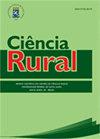犬特应性皮炎:基于临床表型的全身免疫调节方案
IF 0.9
4区 农林科学
Q3 AGRONOMY
引用次数: 0
摘要
摘要:犬特应性皮炎(cAD)是一种与免疫功能障碍和皮肤屏障异常相关的多因素过敏性疾病。几种免疫介质在其发病机制中起作用。这些分子是由辅助性T淋巴细胞(Th)通过向Th1和/或Th2极化激活而产生的,这有助于不同的病变模式。急性病变是由Th2细胞因子轴的激活介导的,它在临床上诱发红斑和瘙痒。相反,在慢性损伤中,发生Th1/Th2细胞因子的混合免疫反应,导致皮肤色素沉着和地衣化。临床理解这些模式和免疫调节剂的作用模式对特应性患者的最佳临床管理至关重要。在此背景下,本文讨论了免疫反应和免疫调节药物在犬特应性皮炎中的作用,并提出了基于临床表型的治疗方案。基于本综述的证据,我们认为使用针对与cAD临床表型相关的细胞因子谱的免疫调节药物是合适的。本文章由计算机程序翻译,如有差异,请以英文原文为准。
Canine atopic dermatitis: systemic immunomodulatory protocol based on clinical phenotype
ABSTRACT: Canine atopic dermatitis (cAD) is a multifactorial allergic disease associated with immune dysfunction and abnormal skin barrier. Several immunological mediators play a role in its pathogenesis. Such molecules are produced by the activation of T helper lymphocytes (Th) through polarization to Th1 and/or Th2, which contributes to different lesion patterns. Acute lesions are mediated by an activation of the Th2 cytokine axis, which clinically induces erythema and pruritus. Conversely, in chronic injuries a mixed immune response of Th1/Th2 cytokines occurs, leading to hyperpigmented and lichenified skin. The clinical understanding of these patterns and the mode of action of immunomodulators are crucial for the best clinical management of the atopic patient. In this context, this review discussed the role of the immune response and the immunomodulatory drugs in dogs with atopic dermatitis and suggested a therapeutic protocol based on clinical phenotype. Based on the evidences showed in this review, it is considered appropriate to use immunomodulatory drugs that target cytokine spectrum related with the clinical phenotype of cAD.
求助全文
通过发布文献求助,成功后即可免费获取论文全文。
去求助
来源期刊

Ciencia Rural
AGRONOMY-
CiteScore
1.70
自引率
0.00%
发文量
233
审稿时长
2-4 weeks
期刊介绍:
The purpose of Ciência Rural is to publish the results of original research, note and reviews which contribute significantly to knowledge in Agricultural Sciences. Preference will be given to original articles that develop news concepts or experimental approaches and are not merely repositories of scientific data. The decison of acceptance for publication lies with the Editors and is based on the recommendations of Editorial Comission, Area Committee and/ or ad hoc reviewers. The editors and reviewers are external to the institution.
 求助内容:
求助内容: 应助结果提醒方式:
应助结果提醒方式:


